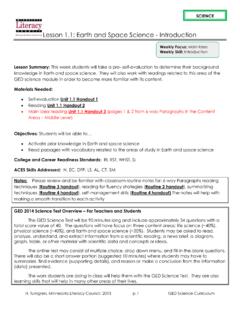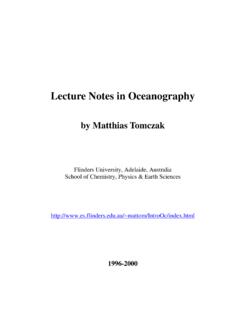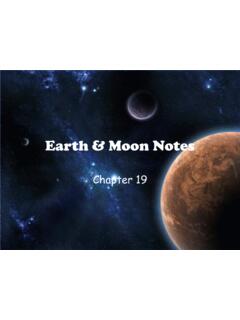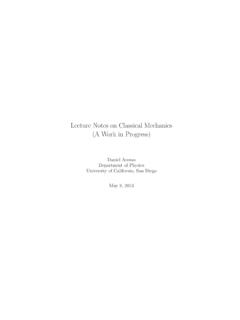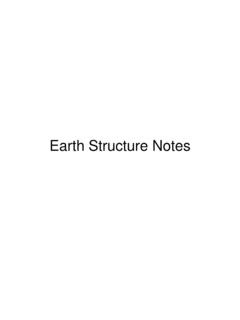Transcription of earth chap 1 lecture - Mr.E Science
1 lecture notes earth Science Chapter 1. What Is Science ? Section 1 Summary Key Concepts What skills do scientists use? What is scientific inquiry? How do scientific theories differ from scientific laws? Science is a way of learning about the natural world. Science also includes all the knowledge gained from exploring the natural world. As scientists seek to understand the natural world, they use skills such as observing, inferring, and predicting. Observing means using one or more of your senses to gather information. When you explain or interpret the things you observe, you are inferring, or making an inference. Predicting means making a forecast of what will happen in the future based on past experience or evidence. Thinking and questioning are the start of the scientific inquiry process.
2 Scientific inquiry refers to the many ways in which scientists study the natural world and propose explanations based on the evidence they gather. Scientific inquiry often begins with a problem or questions about an observation. A hypothesis is a possible explanation for a set of observations or answer to a scientific question. In Science , a hypothesis must be testable. This means that researchers must be able to carry out investigations and gather evidence that will either support or disprove the hypothesis. A scientist designs an experiment to test a hypothesis. An experiment in which only one variable is manipulated at a time is called a controlled experiment. All factors that can change in an experiment are called variables. The variable that is purposely changed to test a hypothesis is called the manipulated variable.
3 The factor that may change in response to the manipulated variable is called the responding variable. A controlled experiment produces data. Data are facts, figures, and other evidence gathered through observations. After gathering and interpreting data, a scientist draws conclusions about the hypothesis. A. scientist then communicates the results of the experiment through writing and speaking with other scientists. A scientific theory is a well-tested explanation for a wide range of observations or experimental results. Future testing can prove a theory incorrect. A scientific law is a statement that describes what scientists expect to happen every time under a particular set of conditions. Unlike a theory, a scientific law describes an observed pattern in nature, but does not provide an explanation for it.
4 Studying earth Section 2 Summary Key Concepts What are the parts of the earth system? How is energy transferred in the earth system? What are the branches of earth Science ? Energy is the ability to do work, or cause change. Energy from the sun is transferred to earth as radiation, a form of energy that can move through space. Although the sun is millions of kilometers away, it affects everything on earth 's surface. The sun is part of a system that includes earth 's air, water, land, and living things. The earth system has four main parts, or "spheres": the atmosphere, hydrosphere, lithosphere, Page 1 of 3. and biosphere. As one source of energy for processes on earth , the sun can also be considered part of the earth system. The outermost sphere is the atmosphere, the mixture of gases that surrounds the planet.
5 earth 's oceans, lakes, rivers, and ice form the hydrosphere. earth 's solid, rocky outer layer is called the lithosphere. The lithosphere is made up of continents and islands, and it extends under the entire ocean floor. Energy from heat in earth 's interior drives some processes that shape the lithosphere. All living things whether in the air, in the oceans, on land, or beneath the land surface make up the biosphere. Matter and energy constantly move from one part of the earth system to another. Matter is what makes up everything in the universe. The movement of matter cannot occur without energy transfer. Energy can be transferred from place to place by moving objects, by waves, or by heat flow. Any moving object or particle transfers energy. For example, wind and flowing water transfer energy through the movement of particles.
6 Energy can also be transferred by waves. A wave is an up-and-down or back-and-forth motion that carries energy from place to place but leaves the matter behind. Sound waves, water waves, and earthquake waves are types of waves that require a medium to travel through. A medium is a material through which a wave travels. Another type of wave, the electromagnetic wave, does not require a medium to travel through. Electromagnetic waves transfer electrical and magnetic energy. Heat is the energy transferred from one object to another as a result of a difference in temperature. Thermal energy is the total energy of all the atoms that make up an object. Heat flow occurs when two objects at different temperatures are brought into contact. Heat always flows from the warmer object to the cooler object.
7 earth Science is the body of knowledge about earth 's land, air, water, and living things. earth Science has several different branches. In this book, you will learn about geology, meteorology, and environmental Science . Geology is the study of the solid earth . Meteorology is the study of earth 's atmosphere. Environmental scientists study earth 's environment and resources. Exploring earth 's Surface Section 3 Summary Key Concepts What does the topography of an area include? What are the main types of landforms? How do maps represent earth 's surface and help find locations? Topography is the shape of the land. An area's topography may be flat, sloping, hilly, or mountainous. The topography of an area includes the area's elevation, relief, and landforms. The height above sea level of a point on earth 's surface is its elevation.
8 The difference between the highest and the lowest points of an area is its relief. A landform is a feature of topography formed by the processes that shape earth 's surface. Different landforms have different combinations of elevation and relief. There are three main types of landforms: plains, mountains, and plateaus. A plain is a landform made up of flat or gently rolling land with low relief. A plain that lies along a seacoast is called a costal plain. In North America, a coastal plain extends around the continent's eastern and southeastern shores. Coastal plains have both low elevation and low relief. A plain that lies away from the coast is called an interior plain. Although interior plains have low relief, their elevation can vary. The broad interior plains of North America are called the Great Plains.
9 A mountain is a landform with high elevation and high relief. Mountains usually occur as part of a mountain range. A mountain range is a group of mountains that are closely related in shape, structure, or age. The different mountain ranges in a region make up a mountain system. Mountain ranges and mountain systems in a long, connected chain form a larger unit called a mountain belt. The Rocky Mountains are part Page 2 of 3. of a mountain belt that stretches down the sides of North and South America. A landform that has high elevation and a more or less level surface is called a plateau. A plateau is rarely perfectly smooth on top. Streams and rivers may cut into the plateau's surface. A map is a flat model of all or part of earth 's surface as seen from above.
10 A map's scale relates distances on a map to distances on earth 's surface. Maps are drawn to scale and use symbols to represent topography and other features on earth 's surface. Two lines, the equator and the prime meridian, are the baselines for measuring distances on earth . Using these lines, mapmakers have constructed a grid made up of lines of latitude and longitude. Degrees can be used to measure distances on the surface of a sphere. The lines of latitude and longitude on a map form a grid that can be used to find locations anywhere on earth . The distance in degrees north or south of the equator is called latitude. The distance in degrees east or west of the prime meridian is railed longitude. Topographic Maps Section 4 Summary Key Concepts How do mapmakers represent elevation, relief, and slope?



